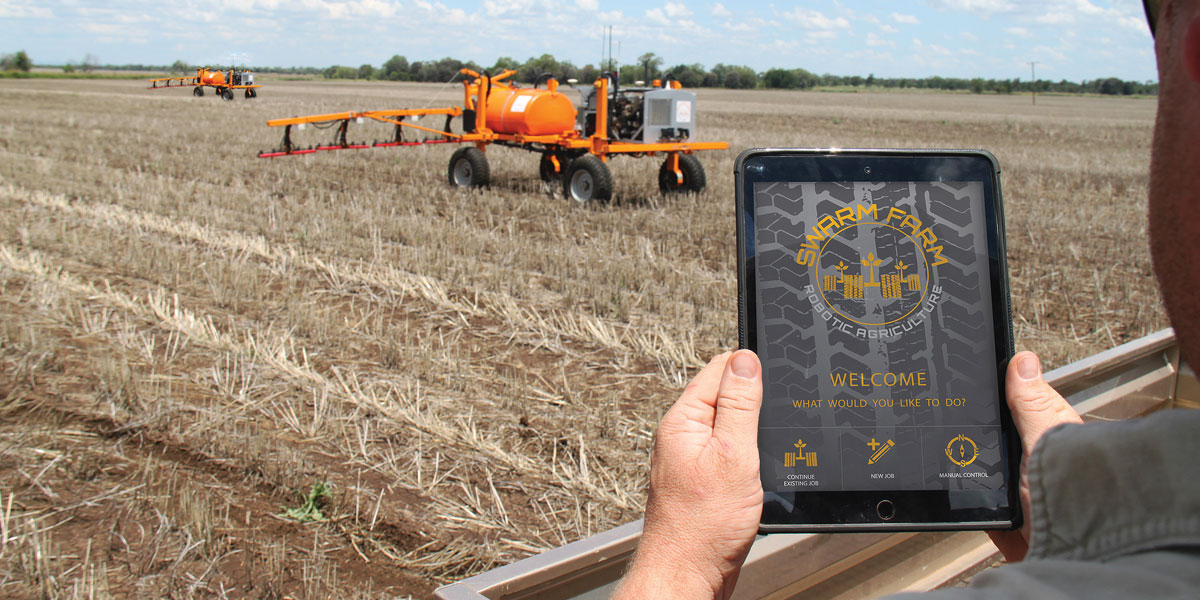The first generation of commercial agricultural robots is making its way onto farms across Australia. However, for many the jury is still out on autonomy and whether the concept and products can prove themselves a valuable cost-effective tool. Sandra Godwin reports how a Queensland grain and beef farmer, and founder of SwarmFarm Robotics, has taken the concept and applied it to agriculture – including turf.
The Turf Swarmbot, delivered last year, is set-up with a mower deck, but can also be configured for blanket spraying, using cameras to guide spot spraying of individual weeds, and spreading fertiliser or other soil additives.
Turf growers are among those leading the adoption of the cutting-edge technology, which was unveiled with the demonstration of a Mowbot at the Turf Australia Annual Conference two years ago.
Since then, SwarmFarm Robotics Founder and Chief Executive Officer Andrew Bate said the first commercial order of the Swarmbot 5 – the fifth iteration of the Mowbot prototype – was delivered to a Brisbane turfgrower in 2018.
Andrew added that production would be ramped-up over the next four years to cater for exponential growth in domestic demand of 2000 or more a year, with 24 already ordered.
“Adoption won’t happen slowly,” he said. “This technology will catch on really quick. There’s interest right across Australia now in every industry, from turf, horticulture orchards to cotton to grain, and in the next five years most farmers will become familiar with robots running in their area, if not on their own farm.”
The Swarmbot 5 is the result of 10,000 hours of operational experience under commercial conditions in mostly broadacre grain and cotton farms. It is a generic base platform that can be tailored to different sectors with specialised attachments suitable for spraying, spreading and mowing.
The Turf Swarmbot, delivered last year, is set-up with a mower deck, but can also be configured for blanket spraying, using cameras to guide spot spraying of individual weeds, and spreading fertiliser or other soil additives.
Andrew said he had been surprised by the level of interest in using robots to cut grass – not only from turf growers, but also for mowing between the rows in fruit and nut orchards, on solar farms and at airports.
Agricultural robots have been a labour of love for more than seven years for Andrew and his wife Jocie, who produce grain and beef cattle south of Emerald, in central QLD.
They started with the lofty ambition of creating better farming systems with a focus on autonomy, not automation, and a desire to overturn the conventional thinking that “bigger is better” when it came to farm machinery.
“At the moment everything we do in agriculture is limited by what we can hook on the back of the tractor or spray tank,” he said. “We wanted to look at how we could do things better, grow crops more efficiently and more sustainably.”
Tractors became a staple in Australian agriculture in the 1900s as a means of increasing the area under crop, reducing the wages bill and increasing production and profits. But the growing size of farms led to the evolution of stronger, faster machinery with a huge price tag.
Andrew said the labour-saving aspect of robots was a major drawcard for many people, but most farmers wanted a better way to produce their crops.
“The robots bring a new field practice and a new opportunity for them to do that,” he said. “It’s also a scaleable technology because you don’t have to be big to run it. A small farmer can have the same technology as a large farmer. The small farmer might have one or two robots and the larger farmer a dozen. We can put the technology in the hands of all farmers, which is pretty exciting.”
The business name SwarmFarm represents their vision of multiple small robots running as a team, rather than one large robot that drives a large tractor and pulls big implements.
“You can see that in the turf industry – the mower decks that people are pulling behind their tractors are enormous nowadays,” he said. “Suddenly you’ve got heavy machines, more soil compaction and, the bigger a mower deck is, the harder it is to get a nice even cut all the way along.
“We’re flipping that … using smaller mower decks that can cut more evenly and the robots are lighter, so we’re taking the weight off paddocks and we can effectively – because they’re unmanned – be in the paddock more often and mow more often to get a better more consistent quality product.”
Andrew said the labour-saving aspect of robots was a major drawcard for many people, but most farmers wanted a better way to produce their crops.
Other benefits include reduced soil disturbance and slower, more precise, timely and economical application of chemicals and nutrients, with less operator exposure and fewer environmental impacts.
The Swarmbot 5 is available on a three-year operating lease at a cost of about $70,000 a year. At the end of the third year, the robot is swapped out for the latest model.
Recent improvements include the addition of road networks to allow robots to travel independently between paddocks and, when the job is finished, return to the shed and park next to the fuel bowser.
A dock and refill system for spraying robots is to be released by the end of the year. When the robots run out of spray or fertiliser, they will go to a docking station, refill the tanks and get back to work. This allows the robots to be lightweight, but still cover large areas.


